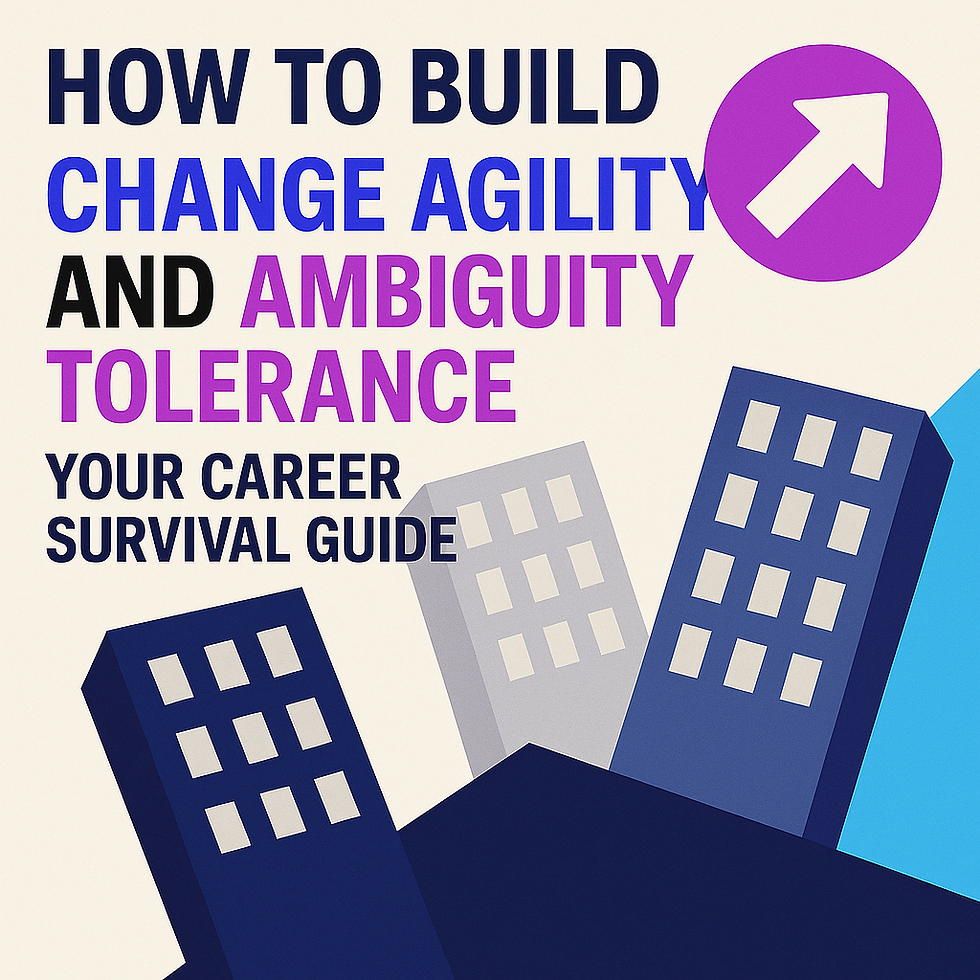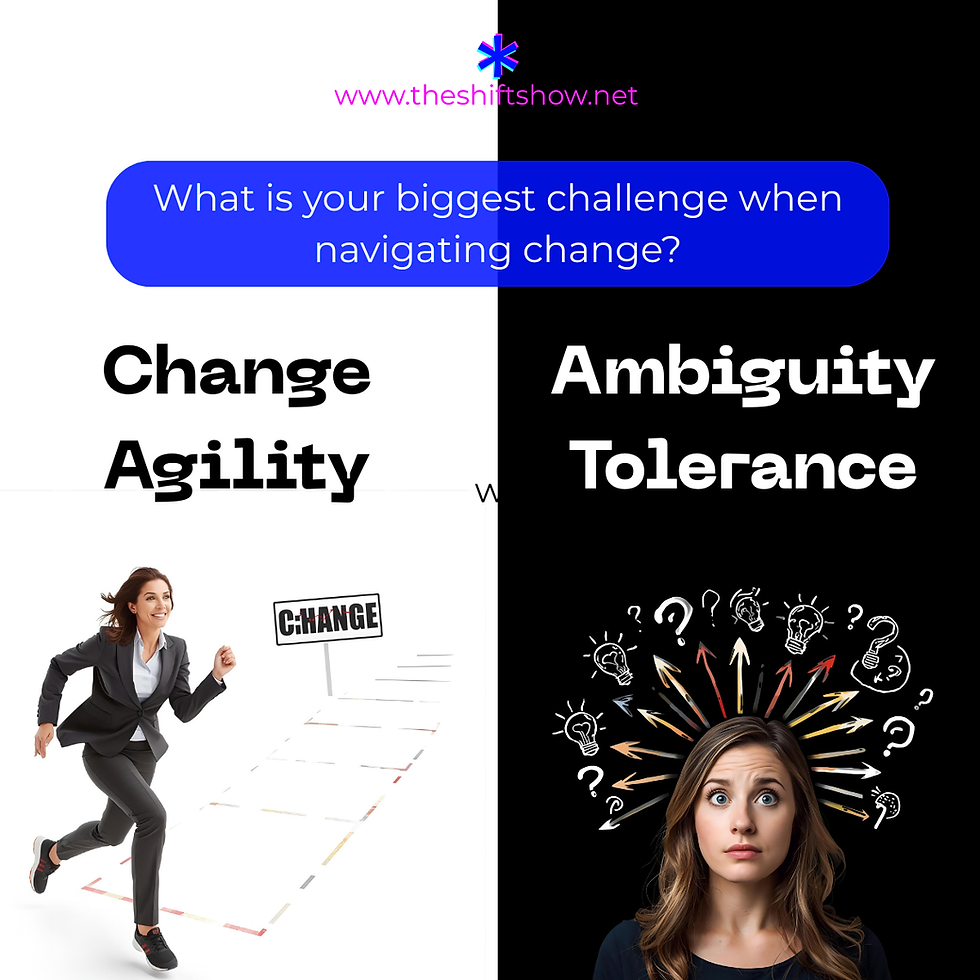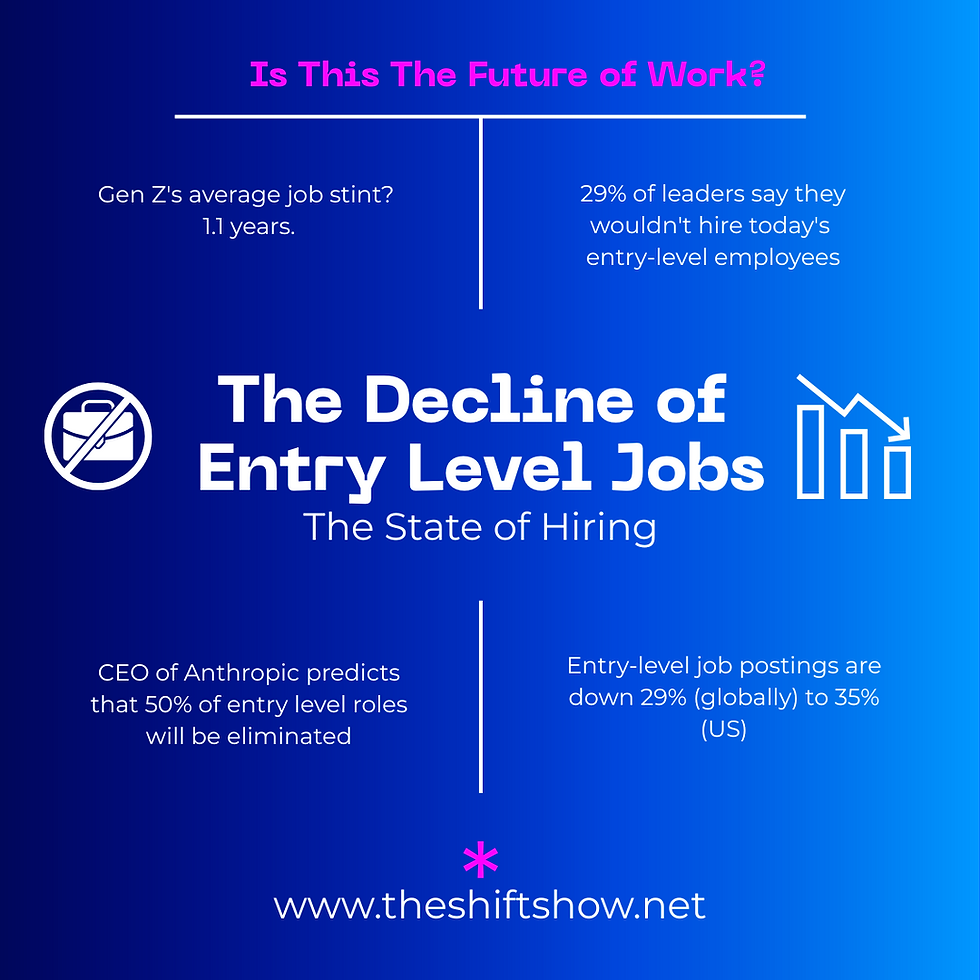Building on Shifting Ground: Why Change Agility and Ambiguity Tolerance Are Your Career Foundation
- Rachel Bourne
- Oct 5
- 6 min read
Updated: Oct 9

Last week's coaching conversation with that Fortune 100 Executive Director is still echoing in my mind. Their vulnerability in admitting that "not knowing what's going to happen" keeps them up at night struck a chord - not just with me, but apparently with many of you who've reached out since.
Here's the thing: We've been looking at change resistance all wrong.
After 20 years of helping organizations and individuals navigate transformation, I'm not convinced that people are afraid of change.
They're afraid of uncertainty. And there's a massive difference between the two.
The Critical Distinction: Change Agility vs. Ambiguity Tolerance
Change Agility: Renovating the Visible Structure
Change agility is like renovating an existing building. You can see what needs updating, you have blueprints to follow, and while it's work, it's manageable.
Take the recent ChatGPT evolution from GPT-4 to GPT-5. I knew it was coming - we all did. I didn't know all the requirements or how it would impact my carefully crafted workflows. Some of my automations broke. My prompting strategies needed updating. But within a week? I'd rebuilt. New features explored, workflows reconstructed, productivity restored.

This is change agility in action:
New technology? Like updating electrical systems - follow the specs, rewire as needed
New leadership directive? Similar to new building codes - understand the requirements, adjust your plans
Market shift? Like neighborhood rezoning - survey the new landscape, adapt your approach
Team restructure? Reconfiguring floor plans - map new workflows, clarify spaces
The same principle applies to those surprise business requirements that cascade down from leadership. You anticipate what you can, retrofit what you must, and reinforce as you go. It's a skill, and like any skill, it improves with practice.
We're actually remarkably good at this external adaptation. Think about it - how many software updates, process changes, and organizational restructures have you successfully navigated in your career? Dozens? Hundreds?
Ambiguity Tolerance: Building on Uncertain Ground
But ambiguity tolerance? That's like being asked to design a building when you don't know if the ground beneath will be solid rock or shifting sand.
It's that knot in your stomach when the company announces another round of layoffs (and let's face it, that's happening more and more). It's the 3 AM worry about whether your role will exist in five years. It's watching AI demos and wondering if that's your professional earthquake coming.
In architecture school, they taught us to design for uncertainty - buildings need to flex with earthquakes, adapt to changing uses over decades, weather storms we can't predict. But it's one thing to build flexibility into concrete and steel. It's another to build it into your career when you can't see the foundation.
Ambiguity tolerance is internal:
Will I still have a job next year? The ground could shift tomorrow.
Is this career pivot the right move? Can't inspect this foundation until you build on it.
Will AI make my expertise irrelevant? The seismic activity is increasing.
Can I provide for my family if things change? The question that shakes our core.
This is the fear that paralyzes. Not the "how" of renovation, but the "what if" of building on uncertain ground.
Building Your Resilience: The Three-Pillar Foundation
Here's what I've learned about thriving in uncertainty - it's not about finding solid ground (that doesn't exist anymore). It's about building a foundation so flexible and strong that it can handle whatever shifts come next.
Think of it as a three-pillar foundation. Even if one pillar takes a hit, the others keep you stable.
Pillar 1: Skills Currency - Your Structural Integrity
Your skills are like the steel beams in your career structure. You could lose the building, but quality steel can be reused, repurposed, rebuilt. No one can take your capabilities from you.
But here's the catch - skills are like building materials. Some deteriorate quickly (technical skills now have a 2-5 year half-life), while others get stronger with age (human skills like communication, emotional intelligence, systems thinking).
Building steps:
Conduct quarterly structural assessments - which skills are load-bearing? Which need reinforcement?
Invest in both technical capabilities AND human skills - you need both steel and flexibility
The "soft skills" will become your differentiator as AI democratizes knowledge, meaning most people will have access to the knowledge that only the most experienced professionals have today
Build learning into your daily routine - 30 minutes daily is like regular maintenance
Document your projects - create a portfolio that shows your skills in action
Pillar 2: Financial Currency - Your Emergency Reinforcement
I'll be transparent here - taking Dave Ramsey's Financial Peace University was like learning proper foundation design for my family's future. We made radical choices: no vacations for years, every bonus went to student loans, we drove older cars while friends upgraded.
Was it hard? Like building in harsh weather. Worth it? Like having a bomb shelter when the storms hit. Now, I’m not endorsing Dave – he’s got a number of issues that I don’t agree with but, it was the start of my financial journey in a new way. It allowed me to invest and Being debt-free didn't just give us financial security - it gave us options.
Over the years, I’ve watched friends walk away from toxic managers, one who’s role was restructured so she became a digital nomad, and another who got laid off and bought a company. These aren't lucky breaks - they're the result of building financial reinforcement before you need it.
Building steps:
Pour an emergency foundation (start with $1,000, build up to 6 months expenses but, to be honest, I think 12 months is more appropriate in this current market and I parked mine in a 6 month CD.)
Eliminate structural debt aggressively - it weakens your whole foundation
Build below your means - excess capacity is strength
Invest in tools and training over decoration
Remember: Financial stability isn't about luxury, it's about having options when the ground shifts
Pillar 3: Social Currency - Your Support Network
Here's a statistic that should change how you build your professional structure: 70% of people get new jobs through acquaintances - not close friends, not family, not cold applications. In architecture, we call this "lateral bracing" - the connections that keep structures stable when individual elements are under stress.
You can't just build connections within your company anymore. That's like only reinforcing one wall - risky and limited.
Building steps:
Dedicate 20% of your professional development to external relationship building
When you attend conferences, squeeze out every networking opportunity
Engage meaningfully on LinkedIn - add value, don't just observe
Join industry associations and actually participate in the community
Offer support before you need it - reciprocity is the strongest joint
I usually hold my lunch breaks open for networking, inside and outside of my company
Maintain your network even when your current structure feels solid
Designing for an Uncertain Future
When you work globally, there is a principle often followed: “Fit for Market”. You design buildings or HR processes for the market in which you’re operating. When things are changing and dynamic, you build for flexibility. Today’s employment and job market are some of the dynamic and toughest we’ve had since 2020 for all professionals and the indicators are that they’re going to get more challenging. I believe that as AI matures, we will need even more robust.
The best buildings aren't the ones that never face stress - they're the ones designed to handle whatever comes.
Your career needs the same approach:
Some days, change comes at you like a planned renovation - clear scope, defined timeline, known outcome. Your change agility kicks in, and you execute the plan.
Other days? It's like building during an earthquake. Nothing's stable, the requirements keep shifting, and you're problem-solving in real-time. That's when ambiguity tolerance becomes your essential skill.
The executives and professionals who thrive aren't the ones who found permanently solid ground - they're the ones who learned to build structures that flex without breaking. They've reinforced their three pillars. They've designed for adaptation. They've accepted that uncertainty isn't a flaw in the system - it's the ground condition of modern work.
Your Blueprint for a Future Proof Career
Assess your foundation: Which challenges you more - the visible renovations or the uncertain ground? Name the weak points to strengthen them.
Build systematically: Pick one pillar to reinforce this quarter. Small, consistent improvements create structural integrity.
Practice flexibility: Take on projects with unclear requirements. Build your tolerance for uncertain ground through controlled exposure.
Connect your structure to others: Share your building challenges. You'll find many successful people are dealing with the same shifting ground.
The future of work isn't about finding solid ground that no longer exists. It's about building structures - careers - that can handle whatever shifts come next.
In architecture school, they taught us that the most beautiful buildings are often those that work with challenging sites, not against them. The same is true for careers. The uncertainty isn't going away - but with the right foundation, you can build something remarkable anyway.
What part of your career foundation needs reinforcement right now? Sometimes identifying the weak point is the first step to strengthening it. I'd love to hear your thoughts and experiences.
For more insights on navigating the future of work, check out The Shift Show podcast where we explore these themes with leaders who are building on shifting ground in real-time.



Comments